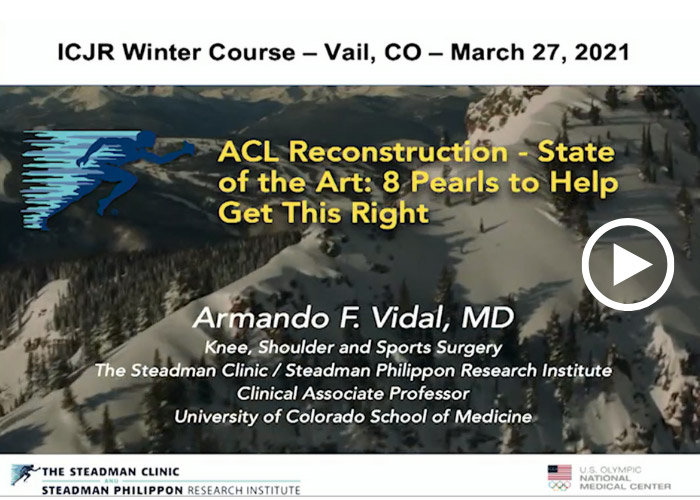8 Pearls for Surgical Reconstruction of the ACL
Dr. Armando Vidal explains the best procedure for ACL reconstruction in a training video at the International Congress for Joint Construction (ICJR)
Anterior cruciate ligament (ACL) injuries account for about half the ligamentous injuries to the knee each year, and result in approximately 200,000 ACL reconstructions at a cost of $7.6 billion annually.
These injuries are becoming increasingly common, particularly in adolescent athletes, making it important for surgeons to have tools that will help them achieve a successful outcome and avoid a difficult revision procedure.
With that in mind, Armando F. Vidal, MD, addressed ACL injuries and reconstruction at ICJR’s 13th Annual Winter Hip & Knee Course, providing his top 8 tips, tricks, and techniques.
He first discussed the definition of “success” in the context of ACL reconstruction. Although many surgeons consider re-tear rates to be the key determinant of success, Dr. Vidal contends that success is far more nuanced. Yes, the re-tear rate is part of it, but success also encompasses the patient’s return to play, level of pain relief, knee motion, and outcomes scores.
Ultimately, Dr. Vidal defines success as “a stable, functional knee that allows the athlete to return to all fitness and sporting activities without restriction or limitation.”
To achieve this successful outcome in his ACL reconstruction patients, he relies on these surgical pearls:
Know what drives the outcome. Dr. Vidal participates in the Multicenter Orthopaedic Outcomes Network (MOON) Group, and the 6-year and 10-year MOON data show that the presence or absence of meniscal or chondral pathology is the biggest driver of outcomes in patients who’ve undergone ACL repair – which means, Dr. Vidal said, that meniscal preservation and patient selection are key to a successful outcome. His institution, the Steadman Philippon Research Institute, is now investigating whether augmenting reconstruction with biologics, such as platelet-rich protein or bone marrow aspirate concentrate, can enhance the outcome.
Make the right diagnosis: Medial side. Although the medial collateral ligament (MCL) will heal on its own in many cases, deciding when it should be addressed during the ACL reconstruction can be difficult due to overlapping and conflicting classification systems. Dr. Vidal will treat the MCL if the patient has:
- Combined instability with a posterior oblique ligament/posteromedial corner injury
- Grade III tibial-side lesion, especially a Stener lesion
- Intra-articular entrapment of the MCL
- Symptomatic chronic injury
In these situations, the MCL will not heal without operative intervention, he said.
Make the right diagnosis: Lateral side. Lateral-side injuries often occur in tandem with ACL injuries, and most can be treated conservatively. Dr. Vidal recommends obtaining stress radiographs if the findings of the clinical exam are concerning.
Use the right graft in the right patient. Graft choice for ACL reconstruction is nuanced and still evolving, Dr. Vidal said. Autograft is generally the best choice, especially in adolescents: Research has shown a re-tear rate of about 7% in adolescents who received an autograft, compared with 20% to 30% for an allograft. In high-demand patients, a bone-patella tendon-bone graft is a better choice than a hamstring graft. The bottom line, Dr. Vidal said, is to choose the graft based on the evidence, individual comfort level with the graft, and the clinical context.
Ensure that the tunnels are in an anatomic position. A variety of techniques are available for independently drilling the femoral tunnels to achieve anatomic positioning. This can include anteromedial portal drilling, flexible reamers, or outside-in with a combined guide pin and reamer device. Grafts that are too vertical or too anterior will not perform kinematically like a normal ACL.
Consider the use of extra-articular augments. Anterolateral complex injury is common with ACL injury. The anterolateral structures are important contributors to lateral stability, and when they are injured, rotational laxity increases. In addition, certain patients will have residual rotational instability after ACL reconstruction, putting them at risk for graft failure. As a result, surgeons have become increasingly interested in anterolateral ligament and lateral extra-articular tenodesis procedures to augment the ACL reconstruction.
Use an evidence-based rehabilitation program. The MOON Group has published an evidence-based rehab program that surgeons can use for their ACL reconstruction patients, Dr. Vidal said.
Make an informed return–to–sport decision. Dr. Vidal uses a variety of metrics to make the return-to-sport decision, including isokinetic strength, validated return-to-sport tests, motion analysis, psychological readiness for return to sport, and time since the injury.
Click the image below to watch Dr. Vidal’s presentation and learn more about ACL reconstruction.
